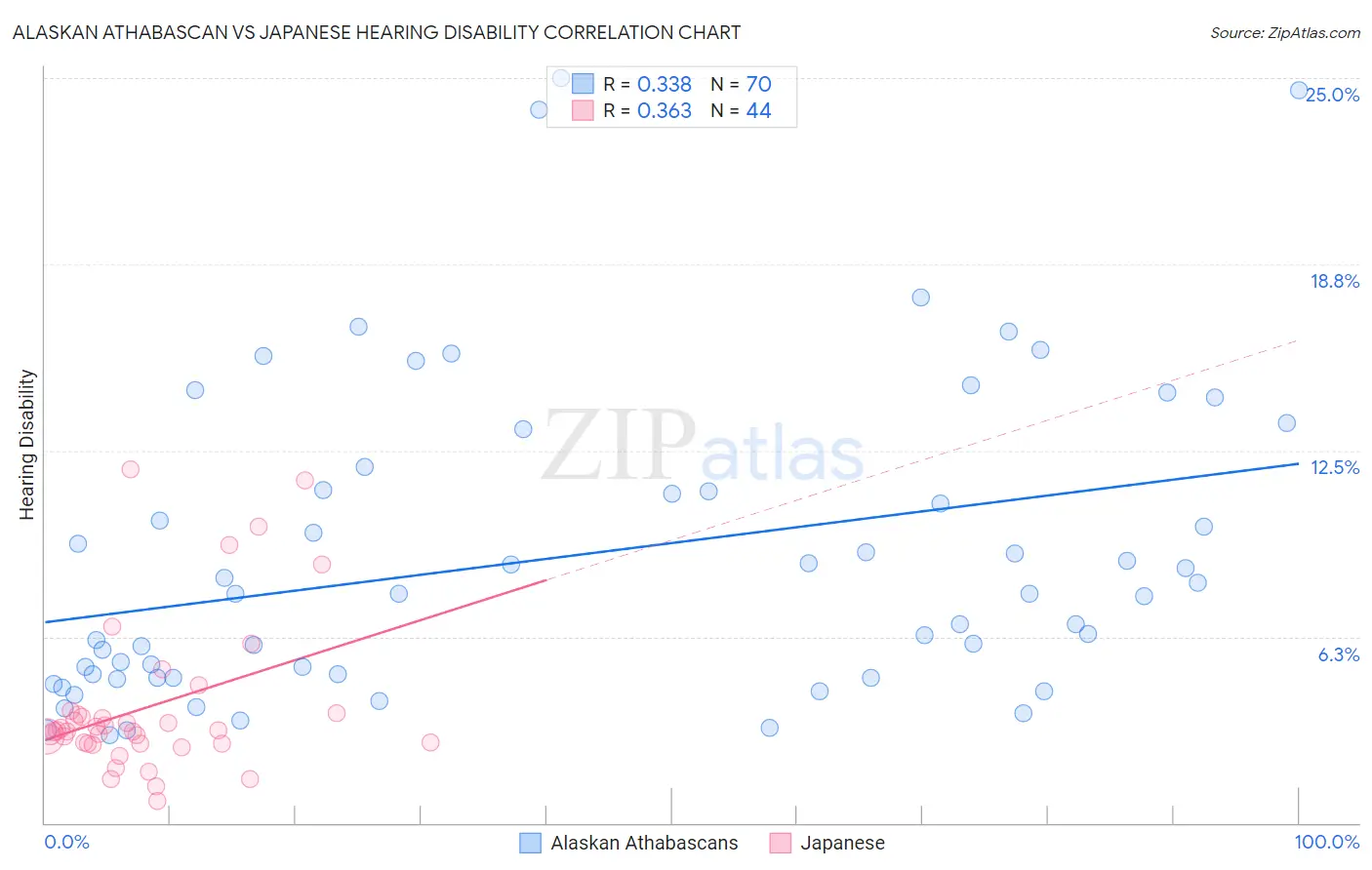Alaskan Athabascan vs Japanese Hearing Disability
COMPARE
Alaskan Athabascan
Japanese
Hearing Disability
Hearing Disability Comparison
Alaskan Athabascans
Japanese
5.3%
HEARING DISABILITY
0.0/ 100
METRIC RATING
345th/ 347
METRIC RANK
3.0%
HEARING DISABILITY
46.0/ 100
METRIC RATING
178th/ 347
METRIC RANK
Alaskan Athabascan vs Japanese Hearing Disability Correlation Chart
The statistical analysis conducted on geographies consisting of 45,819,269 people shows a mild positive correlation between the proportion of Alaskan Athabascans and percentage of population with hearing disability in the United States with a correlation coefficient (R) of 0.338 and weighted average of 5.3%. Similarly, the statistical analysis conducted on geographies consisting of 249,105,269 people shows a mild positive correlation between the proportion of Japanese and percentage of population with hearing disability in the United States with a correlation coefficient (R) of 0.363 and weighted average of 3.0%, a difference of 77.1%.

Hearing Disability Correlation Summary
| Measurement | Alaskan Athabascan | Japanese |
| Minimum | 2.9% | 0.75% |
| Maximum | 25.0% | 11.9% |
| Range | 22.1% | 11.1% |
| Mean | 9.0% | 3.9% |
| Median | 7.7% | 3.1% |
| Interquartile 25% (IQ1) | 4.9% | 2.7% |
| Interquartile 75% (IQ3) | 11.2% | 3.7% |
| Interquartile Range (IQR) | 6.3% | 1.0% |
| Standard Deviation (Sample) | 5.2% | 2.6% |
| Standard Deviation (Population) | 5.2% | 2.6% |
Similar Demographics by Hearing Disability
Demographics Similar to Alaskan Athabascans by Hearing Disability
In terms of hearing disability, the demographic groups most similar to Alaskan Athabascans are Colville (5.3%, a difference of 0.43%), Yup'ik (5.8%, a difference of 9.7%), Tlingit-Haida (4.8%, a difference of 9.9%), Inupiat (4.7%, a difference of 12.9%), and Tsimshian (4.7%, a difference of 13.2%).
| Demographics | Rating | Rank | Hearing Disability |
| Dutch West Indians | 0.0 /100 | #333 | Tragic 4.3% |
| Aleuts | 0.0 /100 | #334 | Tragic 4.3% |
| Kiowa | 0.0 /100 | #335 | Tragic 4.3% |
| Creek | 0.0 /100 | #336 | Tragic 4.4% |
| Chickasaw | 0.0 /100 | #337 | Tragic 4.5% |
| Alaska Natives | 0.0 /100 | #338 | Tragic 4.5% |
| Choctaw | 0.0 /100 | #339 | Tragic 4.5% |
| Pueblo | 0.0 /100 | #340 | Tragic 4.6% |
| Navajo | 0.0 /100 | #341 | Tragic 4.6% |
| Tsimshian | 0.0 /100 | #342 | Tragic 4.7% |
| Inupiat | 0.0 /100 | #343 | Tragic 4.7% |
| Tlingit-Haida | 0.0 /100 | #344 | Tragic 4.8% |
| Alaskan Athabascans | 0.0 /100 | #345 | Tragic 5.3% |
| Colville | 0.0 /100 | #346 | Tragic 5.3% |
| Yup'ik | 0.0 /100 | #347 | Tragic 5.8% |
Demographics Similar to Japanese by Hearing Disability
In terms of hearing disability, the demographic groups most similar to Japanese are Immigrants from Philippines (3.0%, a difference of 0.040%), Panamanian (3.0%, a difference of 0.10%), Immigrants from Romania (3.0%, a difference of 0.23%), Immigrants from Moldova (3.0%, a difference of 0.28%), and Immigrants from Sweden (3.0%, a difference of 0.34%).
| Demographics | Rating | Rank | Hearing Disability |
| Immigrants | Ukraine | 56.6 /100 | #171 | Average 3.0% |
| Armenians | 56.0 /100 | #172 | Average 3.0% |
| Immigrants | Serbia | 51.1 /100 | #173 | Average 3.0% |
| Indonesians | 50.0 /100 | #174 | Average 3.0% |
| Immigrants | Romania | 48.4 /100 | #175 | Average 3.0% |
| Panamanians | 47.0 /100 | #176 | Average 3.0% |
| Immigrants | Philippines | 46.4 /100 | #177 | Average 3.0% |
| Japanese | 46.0 /100 | #178 | Average 3.0% |
| Immigrants | Moldova | 43.1 /100 | #179 | Average 3.0% |
| Immigrants | Sweden | 42.4 /100 | #180 | Average 3.0% |
| Immigrants | Belgium | 41.5 /100 | #181 | Average 3.0% |
| Immigrants | Italy | 41.1 /100 | #182 | Average 3.0% |
| Bulgarians | 39.7 /100 | #183 | Fair 3.0% |
| Immigrants | Ireland | 37.4 /100 | #184 | Fair 3.0% |
| Immigrants | Southern Europe | 35.3 /100 | #185 | Fair 3.0% |